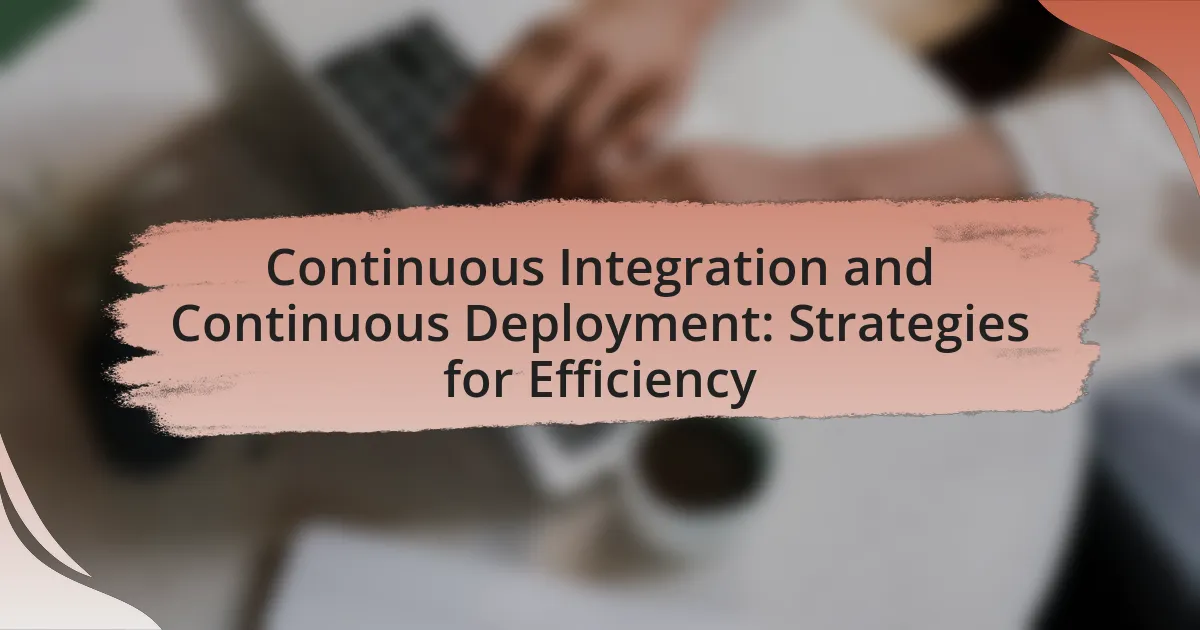Continuous Integration (CI) and Continuous Deployment (CD) are essential software development practices that automate the integration and deployment of code changes, enhancing efficiency and quality. This article explores the definitions, differences, and key principles of CI and CD, highlighting their importance in improving software development processes. It discusses strategies to enhance CI/CD, such as automated testing and containerization, while addressing challenges and common pitfalls teams may encounter. Additionally, the article outlines best practices for successful implementation and the metrics necessary to measure CI/CD success, providing a comprehensive overview of how these methodologies can transform software delivery.

What is Continuous Integration and Continuous Deployment?
Continuous Integration (CI) is a software development practice where code changes are automatically tested and merged into a shared repository multiple times a day, ensuring that new code integrates smoothly with existing code. Continuous Deployment (CD) extends this process by automatically deploying every code change that passes the tests to production, allowing for rapid delivery of new features and fixes to users. This approach enhances collaboration among developers, reduces integration issues, and accelerates the release cycle, as evidenced by studies showing that organizations implementing CI/CD can achieve deployment frequency up to 200 times per day compared to traditional methods.
How do Continuous Integration and Continuous Deployment differ?
Continuous Integration (CI) and Continuous Deployment (CD) differ primarily in their focus and processes. CI emphasizes the frequent integration of code changes into a shared repository, ensuring that new code is automatically tested and validated, which helps identify issues early in the development cycle. In contrast, CD automates the release of validated code to production, allowing for rapid deployment of new features and fixes without manual intervention.
The distinction is evident in their practices: CI involves building and testing code regularly, while CD extends this by automatically deploying the tested code to production environments. According to a 2020 report by the DevOps Research and Assessment (DORA), organizations that implement CI/CD practices can achieve 46 times more frequent code deployments, highlighting the efficiency gained through these methodologies.
What are the key principles of Continuous Integration?
The key principles of Continuous Integration (CI) include frequent code integration, automated testing, and immediate feedback. Frequent code integration ensures that developers merge their changes into a shared repository multiple times a day, which reduces integration problems. Automated testing involves running tests automatically on each integration to detect issues early, thereby maintaining code quality. Immediate feedback provides developers with quick insights into the success or failure of their integrations, allowing for rapid resolution of issues. These principles collectively enhance collaboration and streamline the development process, leading to more efficient software delivery.
What are the key principles of Continuous Deployment?
The key principles of Continuous Deployment include automation, rapid feedback, and incremental changes. Automation ensures that the deployment process is streamlined, reducing human error and increasing efficiency. Rapid feedback allows teams to quickly identify issues and make necessary adjustments, enhancing the overall quality of the software. Incremental changes promote smaller, manageable updates that minimize risk and facilitate easier troubleshooting. These principles collectively support a seamless and efficient deployment pipeline, enabling organizations to deliver software updates to users swiftly and reliably.
Why are Continuous Integration and Continuous Deployment important?
Continuous Integration (CI) and Continuous Deployment (CD) are important because they enhance software development efficiency and quality. CI automates the integration of code changes, allowing teams to detect errors quickly, which reduces the time spent on debugging and increases overall productivity. CD further streamlines the process by automating the deployment of code to production, ensuring that new features and fixes are delivered to users rapidly and reliably. According to a study by DORA (DevOps Research and Assessment), organizations that implement CI/CD practices experience 46 times more frequent code deployments and 96 times faster mean time to recover from failures, demonstrating the significant impact on operational performance and customer satisfaction.
How do they improve software development efficiency?
Continuous Integration (CI) and Continuous Deployment (CD) improve software development efficiency by automating the integration and deployment processes, which reduces manual errors and accelerates delivery times. CI allows developers to frequently merge code changes into a central repository, where automated builds and tests are run, ensuring that issues are identified and resolved quickly. According to a study by DORA (DevOps Research and Assessment), organizations that implement CI/CD practices can achieve 46 times more frequent code deployments and 96 times faster recovery from failures, demonstrating significant efficiency gains in the software development lifecycle.
What impact do they have on software quality?
Continuous Integration (CI) and Continuous Deployment (CD) significantly enhance software quality by enabling frequent code integration and automated testing. This approach allows for early detection of defects, as code changes are validated against the existing codebase regularly. According to a study by Duvall et al. in “Continuous Delivery: Reliable Software Releases through Build, Test, and Deployment Automation,” organizations that implement CI/CD practices report a 30% reduction in production failures and a 50% decrease in the time taken to resolve issues. These statistics demonstrate that CI/CD not only improves the reliability of software releases but also fosters a culture of quality through continuous feedback and iterative improvements.

What strategies can enhance Continuous Integration and Continuous Deployment?
Implementing automated testing is a key strategy that can enhance Continuous Integration and Continuous Deployment (CI/CD). Automated testing ensures that code changes are validated quickly and accurately, reducing the risk of introducing bugs into production. According to a study by the National Institute of Standards and Technology, automated testing can reduce the cost of software development by up to 30% by catching defects early in the development process.
Another effective strategy is to utilize containerization, which allows developers to create consistent environments for applications. This consistency minimizes discrepancies between development and production environments, leading to smoother deployments. Research from Docker indicates that organizations using containerization can achieve deployment speeds that are 10 times faster than traditional methods.
Additionally, integrating continuous monitoring tools can provide real-time feedback on application performance and user experience. This proactive approach allows teams to identify and resolve issues before they impact users, thereby enhancing overall deployment efficiency. A report from Gartner highlights that organizations implementing continuous monitoring can reduce downtime by up to 50%.
In summary, strategies such as automated testing, containerization, and continuous monitoring significantly enhance CI/CD processes by improving code quality, speeding up deployments, and ensuring application reliability.
How can automation be utilized in Continuous Integration and Continuous Deployment?
Automation can be utilized in Continuous Integration (CI) and Continuous Deployment (CD) by streamlining the build, test, and deployment processes. CI tools like Jenkins, CircleCI, and Travis CI automate the integration of code changes, enabling immediate testing and feedback, which reduces integration issues and accelerates development cycles. CD tools such as Spinnaker and GitLab CI/CD automate the deployment of applications to production environments, ensuring consistent and reliable releases. According to the 2021 State of DevOps Report, organizations that implement CI/CD practices experience 46 times more frequent deployments and 440 times faster recovery from failures, demonstrating the effectiveness of automation in enhancing efficiency and reliability in software delivery.
What tools are essential for automating CI/CD processes?
Essential tools for automating CI/CD processes include Jenkins, GitLab CI, CircleCI, Travis CI, and Azure DevOps. Jenkins is widely recognized for its flexibility and extensive plugin ecosystem, enabling integration with numerous tools and services. GitLab CI offers seamless integration with Git repositories, facilitating automated testing and deployment. CircleCI is known for its speed and efficiency in building and deploying applications, while Travis CI is popular for its simplicity and ease of use, particularly in open-source projects. Azure DevOps provides a comprehensive suite of tools for managing the entire development lifecycle, including CI/CD capabilities. These tools collectively enhance the efficiency and reliability of software delivery pipelines.
How does automation reduce human error in deployments?
Automation reduces human error in deployments by standardizing processes and minimizing manual intervention. By utilizing scripts and tools, automation ensures that deployment steps are executed consistently and accurately, reducing the likelihood of mistakes that can occur due to fatigue or oversight. For instance, a study by Puppet in their “State of DevOps Report” found that organizations that implement automation in their deployment processes experience 60% fewer failures. This statistic highlights the effectiveness of automation in enhancing reliability and precision during deployments.
What role does version control play in CI/CD?
Version control is essential in CI/CD as it manages changes to source code, enabling teams to collaborate effectively and maintain a history of modifications. By using version control systems like Git, developers can track changes, revert to previous states, and branch for feature development, which streamlines the integration and deployment processes. This systematic approach reduces conflicts and errors during code integration, ensuring that the latest code is always tested and deployed. Furthermore, version control facilitates automated testing and deployment pipelines, as CI/CD tools can easily access the most recent codebase, ensuring that deployments are consistent and reliable.
How can branching strategies optimize CI/CD workflows?
Branching strategies can optimize CI/CD workflows by enabling parallel development, reducing integration conflicts, and facilitating faster feedback loops. By using strategies such as feature branching, teams can isolate new features or bug fixes in separate branches, allowing multiple developers to work simultaneously without disrupting the main codebase. This isolation minimizes the risk of integration issues when merging changes back into the main branch, as each feature can be tested independently. Additionally, effective branching strategies support automated testing and deployment processes, ensuring that only stable code is integrated into production. Research indicates that organizations employing structured branching strategies experience a 30% reduction in integration issues and a 25% increase in deployment frequency, demonstrating the tangible benefits of optimized workflows.
What are the best practices for managing code repositories?
The best practices for managing code repositories include maintaining a clear branching strategy, implementing regular code reviews, and ensuring comprehensive documentation. A clear branching strategy, such as Git Flow, helps organize development efforts and facilitates collaboration among team members. Regular code reviews enhance code quality and knowledge sharing, reducing the likelihood of bugs and improving maintainability. Comprehensive documentation, including README files and inline comments, ensures that all team members understand the codebase, which is crucial for onboarding new developers and maintaining project continuity. These practices are supported by industry standards, such as the Agile methodology, which emphasizes collaboration and iterative development, leading to more efficient continuous integration and continuous deployment processes.

What challenges are associated with Continuous Integration and Continuous Deployment?
Continuous Integration (CI) and Continuous Deployment (CD) face several challenges, including integration issues, testing complexities, and deployment failures. Integration issues arise when multiple developers work on different features simultaneously, leading to conflicts in code that can disrupt the build process. Testing complexities occur due to the need for comprehensive automated tests that can cover various scenarios, which can be resource-intensive and time-consuming. Deployment failures can happen if the deployment process is not well-defined or if there are environmental discrepancies between development and production, leading to unexpected behavior in live systems. These challenges can hinder the efficiency and reliability of CI/CD practices, making it essential for teams to implement robust strategies to address them.
What common pitfalls should teams avoid in CI/CD implementation?
Teams should avoid several common pitfalls in CI/CD implementation, including inadequate testing, lack of automation, and poor communication. Inadequate testing can lead to undetected bugs in production, which negatively impacts user experience and system reliability. Lack of automation results in manual processes that are error-prone and slow down deployment cycles, undermining the efficiency CI/CD aims to achieve. Poor communication among team members can create silos, leading to misalignment on goals and responsibilities, which hinders collaboration and slows down the development process. Addressing these pitfalls is crucial for successful CI/CD implementation and achieving streamlined workflows.
How can inadequate testing affect CI/CD outcomes?
Inadequate testing can lead to significant failures in CI/CD outcomes by allowing defects to be deployed into production. When testing is insufficient, it fails to identify critical bugs, resulting in software that does not meet quality standards. According to a study by the National Institute of Standards and Technology, poor software quality can cost organizations up to $59 billion annually due to failures and maintenance issues. This highlights that inadequate testing not only compromises the reliability of the software but also increases operational costs and negatively impacts user satisfaction.
What are the risks of poor communication in CI/CD teams?
Poor communication in CI/CD teams leads to significant risks, including increased deployment failures, delayed project timelines, and reduced team morale. When team members do not effectively share information, misunderstandings arise, resulting in errors during the integration and deployment processes. For instance, a study by the Project Management Institute found that poor communication is a primary factor in 56% of project failures. Additionally, lack of clarity can cause misalignment on project goals, leading to wasted resources and duplicated efforts. These factors collectively hinder the efficiency and effectiveness of CI/CD practices, ultimately impacting the overall success of software delivery.
How can organizations overcome CI/CD challenges?
Organizations can overcome CI/CD challenges by implementing automated testing, enhancing collaboration among teams, and adopting a robust CI/CD pipeline. Automated testing ensures that code changes are validated quickly, reducing the risk of defects in production. Enhanced collaboration fosters communication between development and operations teams, which is essential for identifying and resolving issues promptly. A robust CI/CD pipeline, characterized by clear processes and tools, streamlines the integration and deployment of code, minimizing bottlenecks. According to the 2021 State of DevOps Report, organizations with high-performing CI/CD practices deploy 208 times more frequently than their lower-performing counterparts, demonstrating the effectiveness of these strategies in overcoming CI/CD challenges.
What training and resources are necessary for successful CI/CD adoption?
Successful CI/CD adoption requires comprehensive training in DevOps practices, version control systems, and automation tools, along with access to resources such as documentation, online courses, and community forums. Training programs should focus on tools like Jenkins, Git, and Docker, which are essential for automating the integration and deployment processes. Additionally, organizations should provide hands-on workshops and mentorship opportunities to reinforce learning. Research indicates that companies implementing structured training programs see a 30% increase in deployment frequency and a 50% reduction in lead time for changes, demonstrating the effectiveness of investing in training and resources for CI/CD.
How can feedback loops improve CI/CD processes?
Feedback loops can significantly enhance CI/CD processes by enabling rapid identification and resolution of issues. These loops facilitate continuous monitoring and assessment of code changes, allowing teams to receive immediate feedback on the impact of their modifications. For instance, automated testing within the CI/CD pipeline provides real-time insights into code quality, ensuring that defects are detected early. According to a study by D. M. D. Silva et al. in “The Impact of Continuous Integration on Software Quality” (2019), organizations that implemented feedback loops in their CI/CD processes reported a 30% reduction in deployment failures. This demonstrates that effective feedback mechanisms not only streamline development but also improve overall software reliability.
What are the best practices for implementing Continuous Integration and Continuous Deployment?
The best practices for implementing Continuous Integration (CI) and Continuous Deployment (CD) include maintaining a single source repository, automating the build process, running automated tests, and deploying to production frequently. Maintaining a single source repository ensures that all team members work from the same codebase, reducing integration issues. Automating the build process minimizes human error and speeds up the development cycle, while running automated tests helps catch bugs early, ensuring code quality. Frequent deployments to production allow for quicker feedback and adaptation to user needs, which is supported by the fact that companies practicing CI/CD report a 30% increase in deployment frequency and a 50% reduction in lead time for changes, according to the 2020 State of DevOps Report.
How can teams ensure consistent integration and deployment cycles?
Teams can ensure consistent integration and deployment cycles by implementing automated testing and continuous integration tools. Automated testing allows teams to quickly identify and resolve issues in the codebase, while continuous integration tools facilitate the regular merging of code changes into a shared repository. According to a study by Duvall et al. in “Continuous Integration: Improving Software Quality and Reducing Risk,” organizations that adopt these practices experience a 30% reduction in integration issues and a 50% faster deployment cycle. This evidence supports the effectiveness of automation in maintaining consistency in integration and deployment processes.
What metrics should be tracked to measure CI/CD success?
To measure CI/CD success, key metrics include deployment frequency, lead time for changes, change failure rate, and mean time to recovery (MTTR). Deployment frequency indicates how often new releases are deployed, reflecting the team’s ability to deliver updates. Lead time for changes measures the time taken from code commit to deployment, showcasing efficiency in the development process. Change failure rate tracks the percentage of deployments that fail, providing insight into the stability of releases. Mean time to recovery (MTTR) assesses how quickly the team can restore service after a failure, highlighting the effectiveness of incident response. These metrics collectively provide a comprehensive view of the CI/CD pipeline’s performance and areas for improvement.

Leave a Reply